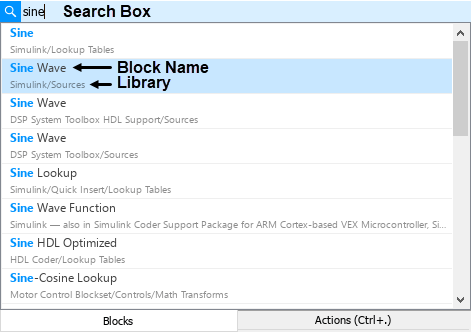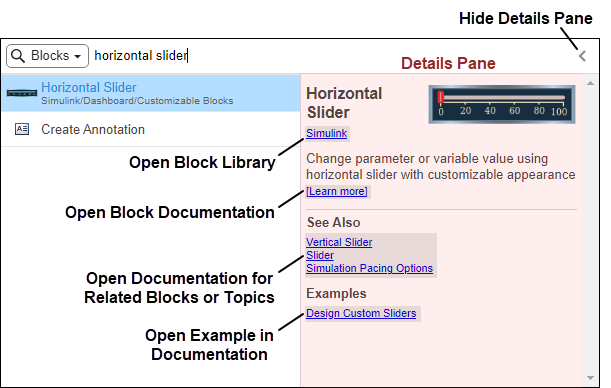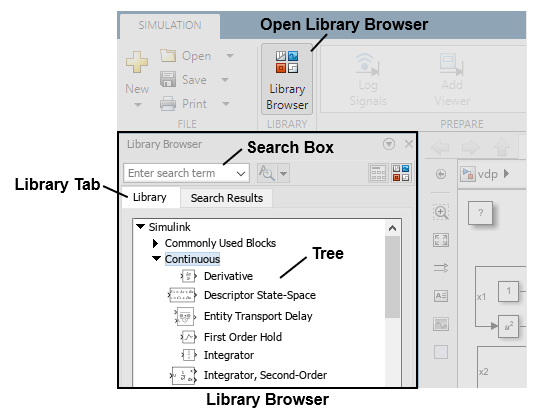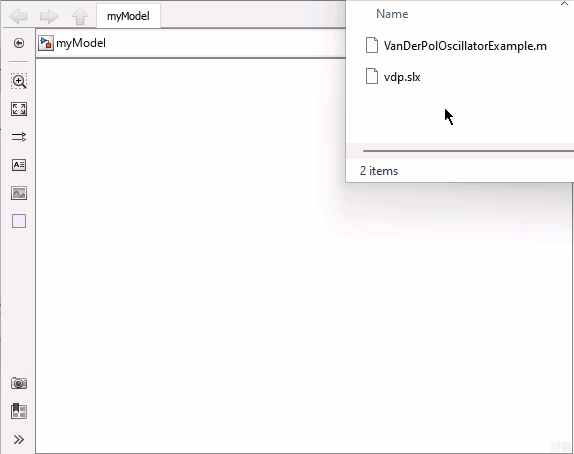向模型添加模块
基本模型接受输入信号,对信号执行运算,并可视化或记录输出。您可以使用模块生成或导入输入信号,修改信号,以及绘制输出信号或将其传递给工作区。您还可以使用模块将模型的内容组织成可重用的组件。
要向模型添加模块,或帮助您决定向模型添加哪些模块,请使用快速插入菜单或库浏览器。要获取有关特定模块的信息,请使用快速插入菜单。要浏览可用模块,请使用库浏览器。
对于表示某些组件的模块,您还有第三种选择。您可以使用快速插入菜单或库浏览器将 Model、Subsystem 或 Reference Component (System Composer) 模块添加到模型中,或将您要模块引用的文件拖到模型画布上。有关详细信息,请参阅通过将文件拖到画布来添加组件。
使用快速插入菜单向模型添加模块
要使用快速插入菜单添加一个模块,请执行以下操作:
在要添加模块的位置,双击 Simulink® 画布。
输入要添加的模块的名称,或通过输入关键字进行搜索。
在搜索结果列表中,使用箭头键选择要添加的模块,然后按 Enter 键。
可能存在多个属于不同库的同名模块。在按 Enter 键之前,请通过检查模块名称下方的库名称和搜索结果右侧详细信息窗格中的信息,确保选定模块是您要添加的模块。

要将模块添加到信号线的未连接端,请执行以下操作:
将指针移到信号线末端上。当指针位于信号线的一端时,它会变为一个圆圈。

双击信号线的一端。
使用出现的快速插入菜单添加模块。新模块连接到您双击的信号线的一端。
使用快速插入菜单详细信息窗格获取有关模块的信息
您可以使用快速插入菜单获取有关模块的信息。在搜索结果中选择模块,然后查看搜索结果右侧的详细信息窗格。您可以使用详细信息窗格完成以下任务。
| 任务 | 如何完成任务 |
|---|---|
| 打开模块库,例如要浏览库中的其他模块。 | 点击模块名称下方的超链接。如果一个模块存在于多个库中,您可能会看到多个超链接。 |
| 确定模块是否为所需的模块(可能存在多个不同的同名模块)。 | 阅读模块描述。 |
| 查找有关模块的信息。 | 点击 Learn More。 |
| 了解相关模块和主题。 | 点击另请参阅下的超链接。 |
| 查看模块用法示例。 | 点击示例下的超链接。 |
要隐藏详细信息窗格,请点击箭头  。要显示详细信息窗格,请再次点击该箭头。
。要显示详细信息窗格,请再次点击该箭头。

使用库浏览器向模型添加模块
要使用库浏览器添加模块,请执行以下操作:
要打开库浏览器,请在 Simulink 工具条的仿真选项卡上,在库部分中,点击库浏览器。
您可以对要添加的模块进行关键字搜索,或通过导航库浏览器树查找模块。
要进行关键字搜索,请在库浏览器的搜索框中输入关键字或关键短语,然后按 Enter 键。搜索结果显示在搜索结果选项卡中。有关详细信息,请参阅按关键字搜索库项。
提示
要在关键字搜索后返回库浏览器树,请点击库选项卡。
找到要添加的模块后,点击它并将其从库选项卡或搜索结果选项卡拖到 Simulink 画布。
或者,选择该模块并按 Ctrl+I 键,或在库浏览器中右键点击该模块并选择向模型添加模块。
有关库浏览器的详细信息,请参阅库浏览器。

使用库浏览器浏览可用模块
您可以使用库浏览器浏览可用的模块。
要打开库浏览器,请在 Simulink 工具条的仿真选项卡上,在库部分中,点击库浏览器。
要浏览可用的模块,请展开树中的库。如果您正在寻找:
生成输入信号的模块,请尝试展开 Simulink 库,然后展开 Sources 子库。
您可以使用 From Workspace 模块从工作区导入数据。您可以使用 From File 模块从文件导入数据。
对一个或多个信号进行运算的模块,请尝试展开 Simulink 库,然后展开 Commonly Used Blocks 或 Math Operations 子库。
例如,如果您要将两个信号相加,可以使用 Math Operations 子库中的 Sum 模块。
输出仿真结果的模块,请尝试展开 Simulink 库,然后展开 Sinks 子库。
您可以使用 Scope 模块绘制仿真结果。您可以使用 To Workspace 模块将仿真结果传递给工作区。您可以使用 To File 模块将仿真结果保存到文件。
有关库浏览器的详细信息,请参阅库浏览器。
通过将文件拖到画布来添加组件
您可以通过将文件拖到模型画布来将表中列出的组件添加到模型中。使用拖放添加方法创建的组件会预配置为引用您拖放的文件内容。例如,将 SLX 文件拖到 Simulink 模型画布会添加 Model 模块,该模块引用 SLX 文件中的模型。
您拖到画布的文件必须位于 MATLAB® 路径中。不支持通过从 MATLAB 编辑器将文件拖到模型画布来创建组件。
| 组件 | 如何向模型添加组件 |
|---|---|
Model 模块 | 将包含您要引用模型的模型文件拖到 Simulink 模型画布。 |
Subsystem 模块 | 将包含您要引用的子系统的子系统文件拖到 Simulink 模型画布。 |
| Reference Component (System Composer) 模块 | 将包含您要引用的模型的模型文件或包含您要引用的子系统的子系统文件拖到架构模型画布。 |
